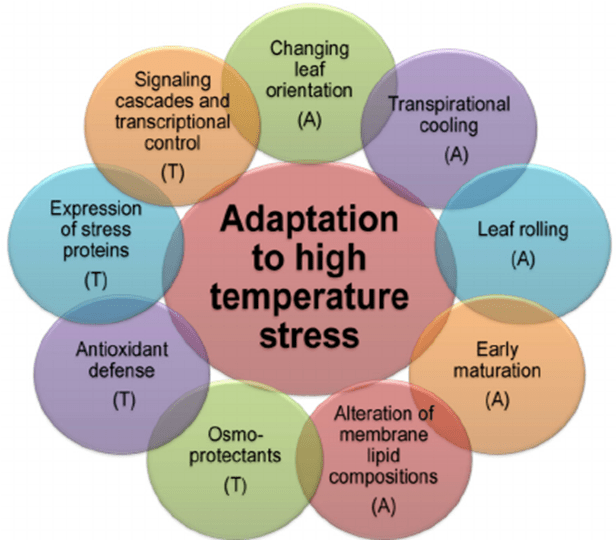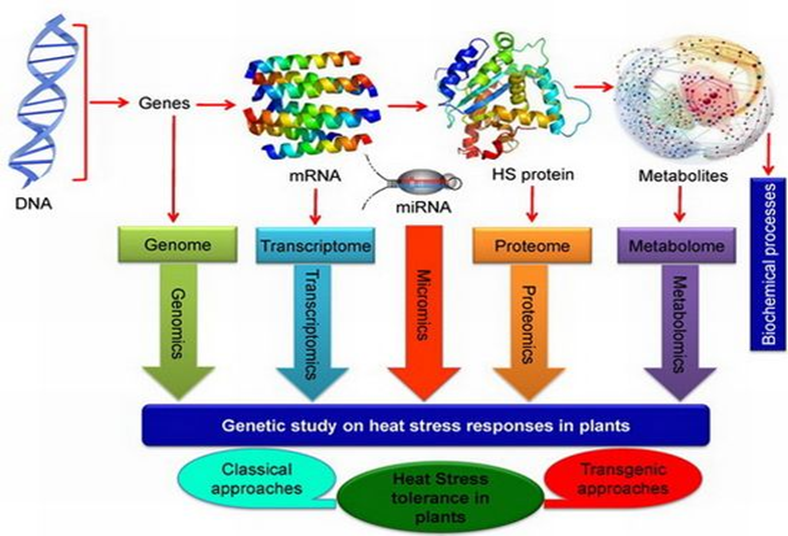Molecular responses of plants to heat stress
Molecular responses of plants to heat stress
Molecular responses
- Oxidative stress and antioxidants
In addition to tissue dehydration, heat stress may induce oxidative stress. For example, generation and reactions of reactivated oxygen species (ROS) including
- singlet oxygen (1O2)
- superoxide radical (O2−)
- hydrogen peroxide (H2O2)
- hydroxyl radical (OH−) are symptoms of cellular injury due to high temperature.
ROS cause the autocatalytic peroxidation of membrane lipids and pigments thus leading to the loss of membrane semi-permeability and modifying its functions.
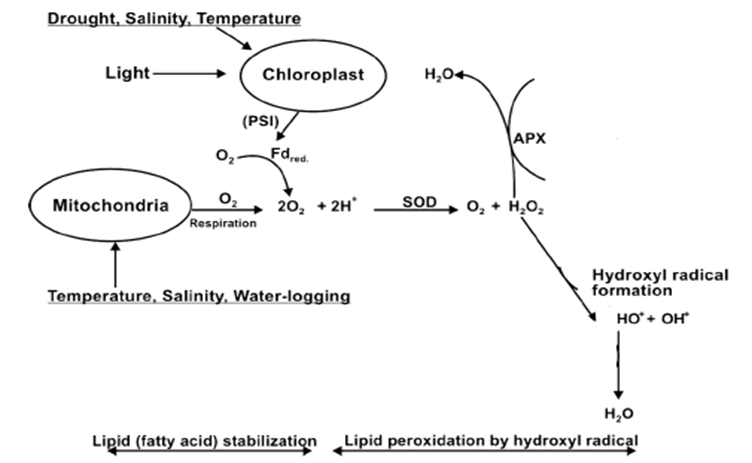
The scavenging of O2− by superoxide dismutase (SOD) results in the production of H2O2, which is removed by APX or CAT.
However, both O2− and H2O2 are not as toxic as the (OH−), which is formed by the combination of O2− andH2O2.
Protection against oxidative stress is an important component in determining the survival of a plant under heat stress.
2. Stress proteins
i) Heat shock proteins
Synthesis and accumulation of specific proteins are ascertained during a rapid heat stress, and these proteins are designated as HSPs.
Increased production of HSPs occurs when plants experience either abrupt or gradual increase in temperature.
Most HSPs function to help cells withstand heat stress by acting as molecular chaperones.
- ¨Heat stress causes many cell proteins that function as enzymes or structural components to become unfolded or misfolded, thereby leading to loss of proper enzyme structure and activity.
- ¨Such misfolded proteins often aggregate and precipitate, creating serious problems within the cell.
- ¨HSPs act as molecular chaperones and serve to attain a proper folding of misfolded, aggregated proteins and to prevent misfolding of proteins.
- ¨This facilitates proper cell functioning at elevated, stressful temperatures.
HSP-triggered thermotolerance is attributed to the observations that
(a) their induction coincides with the organism under stress
(b) their biosynthesis is extremely fast and intensive
(c) they are induced in a wide variety of cells and organisms.
The five classes of heat shock proteins found in plants
| HSP class | Size (kDa) | Examples (Arabidopsis / prokaryotic) | Cellular location |
| HSP100 | 100–114 | AtHSP101 / ClpB, ClpA/C | Cytosol, mitochondria, chloroplasts |
| HSP90 | 80–94 | AtHSP90 / HtpG | Cytosol, endoplasmic reticulum |
| HSP70 | 69–71 | AtHSP70 / DnaK | Cytosol/nucleus, mitochondria, chloroplasts |
| HSP60 | 57–60 | AtTCP-1 / GroEL, GroES | Mitochondria, chloroplasts |
| smHSP | 15–30 | Various AtHSP22, AtHSP20, AtHSP18.2, AtHSP17.6 / IBPA/B | Cytosol, mitochondria, chloroplasts, endoplasmic reticulum |
Functions of HSP
¨Members of the HSP60, HSP70, HSP90, and HSP100 groups act as molecular chaperones, involving
- ¨ATP-dependent stabilization
- ¨folding of proteins
- ¨the assembly of oligomeric proteins.
¨Some HSPs assist in polypeptide transport across membranes into cellular compartments.
¨Low-molecular-weight (15–30 kDa) HSPs are more abundant in higher plants than in other organisms.
¨
2. Other heat induced proteins.
Besides HSPs, there are a number of other plant proteins, including
- ¨ubiquitin
- ¨cytosolic Cu/Zn-SOD and
- ¨Mn-POD
whose expressions are stimulated upon heat stress.
¨For example, in Prosopis chilensis and soybean under heat stress, ubiquitin and conjugated-ubiquitin synthesis during the first 30 min of exposure emerged as an important mechanism of heat tolerance.
Some studies have shown that heat shock induces Mn peroxidase and cytosolic Cu/Zn-SOD, which plays a vital role in minimizing oxidative damages.
Late embryogenesis abundant (LEA) proteins can prevent aggregation and protect the citrate synthase from desiccating conditions like heat- and drought-stress.
Mechanism of heat tolerance
- Thermotolerance
Basal (intrinsic) thermotolerance
an inherent plant ability to survive, exposure to temperatures above the optimal for growth.
Acquired thermotolerance (adaptive) (ATT)
induced by pre- exposure to elevated but non lethal temperatures that gives the ability to survive a subsequent severe heat stress that would be lethal in the absence of the pre conditioning heat treatment.
ATT is transient in nature, and enhances basal thermotolerance and heat endurance.
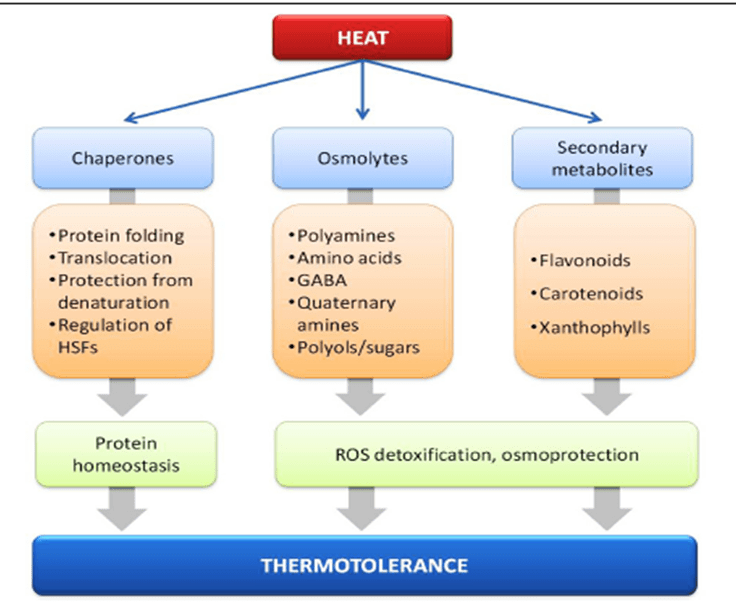
FIGURE | Molecular chaperones and metabolites such as osmolytes and secondary metabolites implicated in heat stress response and thermotolerance.
2. Temperature sensing and signaling
Elucidating the various mechanisms of plant response to stress and their roles in acquired stress tolerance is of great practical and basic importance.
Some major tolerance mechanisms, including
- ion transporters
- Osmoprotectants
- free-radical scavengers
- late embryogenesis abundant proteins
- factors involved in signaling cascades and transcriptional control are essentially significant to counteract the stress effects.
Series of changes and mechanisms, beginning with the perception of heat and signaling and production of metabolites that enable plants to cope with adversaries of heat stress, have been proposed (Figure).
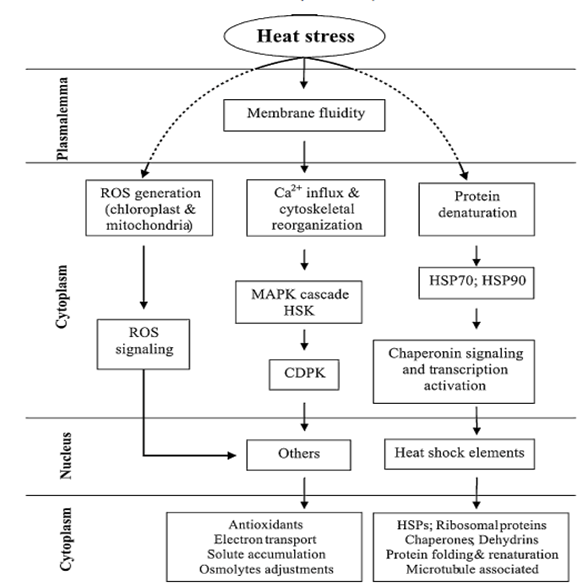
Fig. 3. Proposed heat-stress tolerance mechanisms in plants. MAPK, mitogen activated protein kinases; ROS, reactive oxygen species; HAMK, heat shock activated MAPK; HSE, heat shock element; HSPs, heat shock proteins; CDPK, calcium dependent protein kinase; HSK, histidine kinase. Partly adopted from Sung et al. (2003).
Heat stress effects are notable at various levels, including plasma membrane and biochemical pathways operative in the cytosol or cytoplasmic organelles.
Initial effects of heat stress, however, are on plasmalemma, which shows more fluidity of lipid bilayer under stress.
This leads to the
induction of Ca2+ influx and cytoskeletal reorganization, resulting in the upregulation of mitogen activated protein kinases (MAPK) and calcium dependent protein kinase (CDPK).
Signaling of these cascades at nuclear level leads to the production of antioxidants and compatible osmolytes for cell water balance and osmotic adjustment.
Production of ROS in the organelles (e.g., chloroplast and mitochondria) is of great significance for signaling as well as production of antioxidants.
The antioxidant defense mechanism is a part of heat-stress adaptation, and its strength is correlated with acquisition of thermotolerance
Induction of heat tolerance
¨Considerable attention has been devoted to the induction of heat tolerance in existing high-yielding cultivars
¨Among the various methods to achieve this goal, foliar application of, or pre-sowing seed treatment with low concentrations of
¨ inorganic salts,
¨osmoprotectants,
¨ signaling molecules (e.g., growth hormones)
¨oxidants (e.g., H2O2)
¨preconditioning of plants are common approaches.
